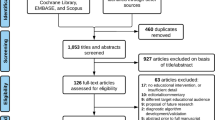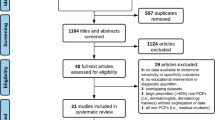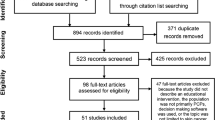ABSTRACT
BACKGROUND
Early detection of melanoma may provide an opportunity to positively impact melanoma mortality. Numerous skin cancer educational interventions have been developed for primary care physicians (PCPs) to improve diagnostic accuracy. Standardized training is also a prerequisite for formal testing of melanoma screening in the primary care setting.
OBJECTIVE
We conducted a systematic review to determine the extent of evaluated interventions designed to educate PCPs about skin cancer, including melanoma.
DESIGN
Relevant studies in the English language were identified through systemic searches performed in MEDLINE, EMBASE, BIOSIS, and Cochrane through December 2010. Supplementary information was obtained from corresponding authors of the included studies when necessary.
APPROACH
Studies eligible for inclusion formally evaluated skin cancer education interventions and were designed primarily for PCPs. Excluded studies lacked a specified training intervention, used decision-making software, focused solely on risk factor identification, or did not directly educate or assess participants. Twenty studies met the selection criteria. Data were extracted according to intervention content and delivery format, and study outcomes.
KEY RESULTS
All interventions included instructions about skin cancer diagnosis, but otherwise varied in content. Curricula utilized six distinct educational techniques, usually incorporating more than one. Intervention duration varied from 12 min to over 6 h. Eight of the 20 studies were randomized trials. Most studies (18/20, 90%) found a significant improvement in at least one of the following five outcome categories: knowledge, competence, confidence, diagnostic performance, or systems outcomes. Competence was most commonly measured; no study evaluated all categories. Variability in study design, interventions, and outcome measures prevented correlation of outcomes with intervention characteristics.
CONCLUSIONS
Despite the development of many isolated educational interventions, few have been tested rigorously or evaluated under sufficient standardized conditions to allow for quantitative comparison. Improved and rigorously tested skin cancer educational interventions for PCPs with outcome measures focusing on changes in performance are needed.

Similar content being viewed by others
REFERENCES
Diepgen TL, Mahler V. The epidemiology of skin cancer. Brit J Dermatol. 2002;146(61):1–6.
Linos E, Swetter SM, Cockburn MG, Colditz GA, Clarke CA. Increasing burden of melanoma in the United States. J Invest Dermatol. 2009;129:1666–74.
Balch CM, Gershenwald JE, Soong SJ, et al. Final version of 2009 AJCC melanoma staging and classification. J Clin Oncol. 2009;27:6199–206.
Wartman D, Weinstock M. Are we overemphasizing sun avoidance in protection from melanoma? Cancer Epidemiol Biomarkers Prev. Mar. 2008;17:469–70.
Weinstock M. The struggle for primary prevention of skin cancer. Am J Prev Med. 2008;34:171–2.
Geller A, Colditz G, Oliveria S, et al. Use of sunscreen, sunburning rates, and tanning bed use among more than 10,000 US children and adolescents. Pediatrics. 2002;109:1009–14.
Cokkinides V, Weinstock M, Glanz K, Albano J, Ward E, Thun M. Trends in sunburns, sun protection practices, and attitudes toward sun exposure protection and tanning among US adolescents, 1998–2004. Pediatrics. 2006;118:853.
Resneck J, Kimball A. The dermatology workforce shortage. J Am Acad Dermatol. 2004;50:50–4.
Weinstock MA. Early detection of melanoma. JAMA. 2000;284:886–9.
Fleischer AB Jr, Herbert CR, Feldman SR, O’Brien F. Diagnosis of skin disease by nondermatologists. Am J Manag Care. 2000;6:1149–56.
Dolan NC. Skin cancer control in the primary care setting: are we making any progress? J Gen Intern Med. 2001;16:342–3.
Geller AC, Koh HK, Miller DR, Clapp RW, Mercer MB, Lew RA. Use of health services before the diagnosis of melanoma: implications for early detection and screening. J Gen Intern Med. 1992;7:154–7.
Sheth N, Sarker SJ, Harries M, Healy C, Russell-Jones R, Acland K. Predictors of patient satisfaction with initial diagnosis and management of malignant melanoma. Clin Exp Dermatol. 2009 Oct 23.
Cherry DK, Hing E, Woodwell DA, Rechtsteiner EA. National Ambulatory Medical Care Survey: 2006 summary. Natl Health Stat Report. 2008;6:1–39.
Schneider J, Moore D, Mendelsohn M. Screening program reduced melanoma mortality at the Lawrence Livermore National Laboratory, 1984 to 1996. J Am Acad Dermatol. 2008;58:741–9.
Aitken J, Elwood J, Lowe J, Firman D, Balanda K, Ring I. A randomised trial of population screening for melanoma. J Med Screen. 2002;9:33.
US Preventive Services Task Force. Screening for Skin Cancer: US Preventive Services Task Force Recommendation Statement. Ann Intern Med. 2009;150:188–93.
Wolff T, Tai E, Miller T. Screening for skin cancer: an update of the evidence for the US Preventive Services Task Force. Ann Intern Med. 2009;150:194–8.
Gerbert B, Maurer T, Berger T, et al. Primary care physicians as gatekeepers in managed care. Primary care physicians’ and dermatologists’ skills at secondary prevention of skin cancer. Arch Dermatol. 1996;132:1030–8.
Feldman SR, Fleischer AB Jr. Skin examinations and skin cancer prevention counseling by US physicians: a long way to go. J Am Acad Dermatol. 2000;43:234–7.
Chen SC, Bravata DM, Weil E, Olkin I. A comparison of dermatologists’ and primary care physicians’ accuracy in diagnosing melanoma: a systematic review. Arch Dermatol. 2001;137:1627–34.
Wise E, Singh D, Moore M, et al. Rates of skin cancer screening and prevention counseling by US medical residents. Arch Dermatol. 2009;145:1131–6.
Moore MM, Geller AC, Zhang Z, et al. Skin cancer examination teaching in US medical education. Arch Dermatol. 2006;142:439–44.
Little JM Jr, Hall MN, Pettice YJ. Teaching dermatology: too dependent on dermatologists? Fam Med. 1993;25:92–4.
Stephenson A, From L, Cohen A, Tipping J. Family physicians’ knowledge of malignant melanoma. J Am Acad Dermatol. 1997;37:953–7.
Friedman KP, Whitaker-Worth DL, Grin C, Grant-Kels JM. Melanoma screening behavior among primary care physicians. Cutis. 2004;74:305–11.
Kirsner R, Muhkerjee S, Federman D. Skin cancer screening in primary care: prevalence and barriers. J Am Acad Dermatol. 1999;41:564–6.
Anderson RT, Dziak K, McBride J, Camacho F, Hege AC, Torti FM. Demand for continuing medical education programs on cancer care among primary care physicians in North Carolina. N C Med J. 2004;65:130–5.
Garrido E, GarcÃa V, Nogales A. Continuing education in primary care: the educational needs of its professionals. Atencion primaria/Sociedad Española de Medicina de Familia y Comunitaria. 2002;30:368.
Liberati A, Altman DG, Tetzlaff J. The PRISMA Statement for Reporting Systematic Reviews and Meta-Analyses of Studies That Evaluate Health Care Interventions: Explanation and Elaboration. Ann Int Med. 2009;151:W-65–W-94.
Jemal A, Siegel R, Ward E, Hao Y, Xu J, Thun MJ. Cancer statistics. CA Cancer J Clin. 2009;59:225–49.
Cook DA, Levinson AJ, Garside S, Dupras DM, Erwin PJ, Montori VM. Internet-based learning in the health professions: a meta-analysis. JAMA. 2008;300:1181–96.
Raasch BA, Hays R, Buettner PG. An educational intervention to improve diagnosis and management of suspicious skin lesions. J Contin Educ Health Prof. 2000;20:39–51.
Youl PH, Raasch BA, Janda M, Aitken JF. The effect of an educational programme to improve the skills of general practitioners in diagnosing melanocytic/pigmented lesions. Clin Exp Dermatol. 2007;32:365–70.
Mikkilineni R, Weinstock M, Goldstein M, Dube C, Rossi J. Impact of the Basic Skin Cancer Triage Curriculum on providers’ skin cancer control practices. J Gen Int Med. 2001;16:302–7.
Mikkilineni R, Weinstock M, Goldstein M, Dube C, Rossi J. The impact of the basic skin cancer triage curriculum on providers’ skills, confidence, and knowledge in skin cancer control. Prev Med. 2002;34:144–52.
Harris JM Jr, Salasche SJ, Harris RB. Using the Internet to teach melanoma management guidelines to primary care physicians. J Eval Clin Pract. 1999;5:199–211.
Harris JM, Salasche SJ, Harris RB. Can Internet-based continuing medical education improve physicians’ skin cancer knowledge and skills? J Gen Intern Med. 2001;16:50–6.
Harris JM Jr, Salasche SJ, Harris RB. Infopoints—The internet and the globalisation of medical education. BMJ. 2001;323:1106.
Argenziano G, Puig S, Zalaudek I, et al. Dermoscopy improves accuracy of primary care physicians to triage lesions suggestive of skin cancer. J Clin Oncol. 2006;24:1877.
Binder M, Schwarz M, Winkler A, et al. Epiluminescence microscopy. A useful tool for the diagnosis of pigmented skin lesions for formally trained dermatologists. Arch Dermatol. 1995;131:286–91.
Soyer H, Argenziano G, Zalaudek I, et al. Three-point checklist of dermoscopy. A new screening method for early detection of melanoma. Dermatology. 2004;208:27–31.
Stolz W, Riemann A, Cognetta A, et al. ABCD rule of dermatoscopy: a new practical method for early recognition of malignant melanoma. Eur J Dermatol. 1994;4:521–7.
Dolianitis C, Kelly J, Wolfe R, Simpson P. Comparative performance of 4 dermoscopic algorithms by nonexperts for the diagnosis of melanocytic lesions. Arch Dermatol. 2005;141:1008–14.
Menzies SW. A method for the diagnosis of primary cutaneous melanoma using surface microscopy. Dermatol Clin. 2001;19:299–305.
Argenziano G, Soyer HP, Chimenti S, et al. Dermoscopy of pigmented skin lesions: results of a consensus meeting via the Internet. J Am Acad Dermatol. 2003;48:679–93.
Westerhoff K, McCarthy W, Menzies S. Increase in the sensitivity for melanoma diagnosis by primary care physicians using skin surface microscopy. Br J Dermatol. 2000;143:1016.
Menzies SW, Emery J, Staples M, et al. Impact of dermoscopy and short-term sequential digital dermoscopy imaging for the management of pigmented lesions in primary care: a sequential intervention trial. Br J Dermatol. 2009 Jun 27.
Bloom BS. Effects of continuing medical education on improving physician clinical care and patient health: a review of systematic reviews. Int J Technol Assess Health Care. 2005;21:380–5.
Davis D, O’Brien MA, Freemantle N, Wolf FM, Mazmanian P, Taylor-Vaisey A. Impact of formal continuing medical education: do conferences, workshops, rounds, and other traditional continuing education activities change physician behavior or health care outcomes? JAMA. 1999;282:867–74.
Satterlee WG, Eggers RG, Grimes DA. Effective medical education: insights from the Cochrane Library. Obstet Gynecol Surv. 2008;63:329–33.
Mansouri M, Lockyer J. A meta-analysis of continuing medical education effectiveness. J Contin Educ Health Prof. 2007;27:6–15. Winter.
Slotnick HB. How doctors learn: the role of clinical problems across the medical school-to-practice continuum. Acad Med. 1996;71:28–34.
Dutta P, Biltz G, Johnson P, et al. SimCare: A Model for Studying Physician Decisionmaking Activity. Advances in patient safety: from research to implementation: Programs, Tools, and Products. 2005;4:21–4.
O’Connor PJ, Sperl-Hillen JM, Johnson PE, et al. Simulated physician learning intervention to improve safety and quality of diabetes care: a randomized trial. Diabetes Care. 2009;32:585–90.
Fordis M, King JE, Ballantyne CM, et al. Comparison of the instructional efficacy of Internet-based CME with live interactive CME workshops: a randomized controlled trial. JAMA. 2005;294:1043–51.
Casebeer L, Kristofco RE, Strasser S. Standardizing evaluation of on-line continuing medical education: physician knowledge, attitudes, and reflection on practice. J Contin Educ Health Prof. 2004;24:68–75. Spring.
Curran VR, Fleet L. A review of evaluation outcomes of web-based continuing medical education. Med Educ. 2005;39:561–7.
Durbec F, Vitry F, Granel-Brocard F, et al. The role of circumstances of diagnosis and access to dermatological care in early diagnosis of cutaneous melanoma: a population-based study in France. Arch Dermatol. Mar;146:240–6.
Davis DA, Thomson MA, Oxman AD, Haynes RB. Changing physician performance. A systematic review of the effect of continuing medical education strategies. JAMA. 1995;274:700–5.
Cabana MD, Rand CS, Powe NR, et al. Why don’t physicians follow clinical practice guidelines? A framework for improvement. JAMA. 1999;282:1458–65.
Smith WR. Evidence for the effectiveness of techniques To change physician behavior. Chest. 2000;118:8S–17S.
Davis D, Galbraith R. Continuing medical education effect on practice performance: effectiveness of continuing medical education: American College of Chest Physicians Evidence-Based Educational Guidelines. Chest. 2009;135:42S–8S.
Colliver JA, Kucera K, Verhulst SJ. Meta-analysis of quasi-experimental research: are systematic narrative reviews indicated? Med Educ. Sep. 2008;42:858–65.
Girgis A, Sanson-Fisher RW, Howe C, Raffan B. A skin cancer training programme: evaluation of a postgraduate training for family doctors. Med Educ. 1995;29:364–71.
Burton R, Howe C, Adamson L, et al. General practitioner screening for melanoma: sensitivity, specificity, and effect of training. J Med Screen. 1998;5:156.
Del Mar C, Green A. Aid to diagnosis of melanoma in primary medical care. Br Med J. 1995;310:492–5.
English D, Burton R, Del Mar C, Donovan R, Ireland P, Emery G. Evaluation of aid to diagnosis of pigmented skin lesions in general practice: controlled trial randomised by practice. BMJ. 2003;327:375.
Dolan N, Ng J, Martin G, Robinson J, Rademaker A. Effectiveness of a skin cancer control educational intervention for internal medicine housestaff and attending physicians. J Gen Int Med. 1997;12:531–6.
Gerbert B, Bronstone A, Wolff M, et al. Improving primary care residents’ proficiency in the diagnosis of skin cancer. J Gen Int Med. 1998;13:91–7.
Gerbert B, Bronstone A, Maurer T, Berger T, McPhee S, Caspers N. The effectiveness of an Internet-based tutorial in improving primary care physicians’ skin cancer triage skills. J Cancer Educ. 2002;17:7.
Bedlow A, Cliff S, Melia J, Moss S, Seyan R, Harland C. Impact of skin cancer education on general practitioners’ diagnostic skills. Clin Exp Dermatol. 2000;25:115.
Brochez L, Verhaeghe E, Bleyen L, Naeyaert J. Diagnostic ability of general practitioners and dermatologists in discriminating pigmented skin lesions. J Am Acad Dermatol. 2001;44:979.
de Gannes G, Ip J, Martinka M, Crawford R, Rivers J. Early detection of skin cancer by family physicians: a pilot project. J Cutan Med Surg. 2004;8:103–9.
Carli P, De Giorgi V, Crocetti E, Caldini L, Ressel C, Giannotti B. Diagnostic and referral accuracy of family doctors in melanoma screening: effect of a short formal training. Eur J Cancer Prev. 2005;14:51.
Argenziano G, Puig S, Zalaudek I, et al. Dermoscopy improves accuracy of primary care physicians to triage lesions suggestive of skin cancer. J Clin Oncol. 2006;24:1877–82.
Peuvrel L, Quereux G, Jumbou O, Sassolas B, Lequeux Y, Dreno B. Impact of a campaign to train general practitioners in screening for melanoma. Eur J Cancer Prev. 2009;18:225.
Contributors
None.
Funders
This study was supported in part by a research grant from the Melanoma Research Alliance. The sponsors had no role in the design and conduct of the study; in the collection, analysis, and interpretation of data; or in the preparation, review, or approval of the manuscript.
Prior presentations
None.
Conflict of Interest
Jacqueline M. Goulart, BA, Stephen Dusza, DrPH, Gwen Alexander, PhD, Melody J. Eide, MD, Ashfaq A. Marghoob, MD, and Allan C. Halpern, MD, have nothing to disclose. Elizabeth A. Quigley, MD, reports honoraria received from Novartis Pharmaceuticals in 2009 and 2010 for skin screening and employee-health lectures. Maryam M. Asgari, MD, reports a grant received from Novartis Pharmaceuticals (2009). Suzanne W. Fletcher, MD, MSc, reports stock ownership of Berkshire Hathaway and honoraria received from UpToDate (editor, primary care) and Wolters-Kluwer (author, Clinical Epidemiology-The Essentials). Alan C. Geller, MPH, reports honoraria from UpToDate (author, skin cancer). Martin A. Weinstock, MD, PhD, reports employment by University Dermatology Inc.; consultancies for Abbott, Astellas, Conrail, Johnson&Johnson, Nordic Biotech, Roche, Schering; and expert testimony for Playtex.
Author information
Authors and Affiliations
Consortia
Corresponding author
Additional information
Members of the INFORMED Group include: Gwen Alexander, PhD; Maryam M. Asgari, MD; Melody J. Eide, MD; Suzanne W. Fletcher, MD, MSc; Alan C. Geller, MPH; Allan C. Halpern, MD; and Martin A. Weinstock, MD, PhD
Electronic Supplmentary Materials
Below is the link to the electronic supplementary material.
ESM 1
(DOC 15 kb)
Rights and permissions
About this article
Cite this article
Goulart, J.M., Quigley, E.A., Dusza, S. et al. Skin Cancer Education for Primary Care Physicians: A Systematic Review of Published Evaluated Interventions. J GEN INTERN MED 26, 1027–1035 (2011). https://doi.org/10.1007/s11606-011-1692-y
Received:
Revised:
Accepted:
Published:
Issue Date:
DOI: https://doi.org/10.1007/s11606-011-1692-y




